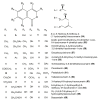Naturally Occurring Isocoumarins Derivatives from Endophytic Fungi: Sources, Isolation, Structural Characterization, Biosynthesis, and Biological Activities
- PMID: 31963586
- PMCID: PMC7024277
- DOI: 10.3390/molecules25020395
Naturally Occurring Isocoumarins Derivatives from Endophytic Fungi: Sources, Isolation, Structural Characterization, Biosynthesis, and Biological Activities
Abstract
Recently, the metabolites separated from endophytes have attracted significant attention, as many of them have a unique structure and appealing pharmacological and biological potentials. Isocoumarins represent one of the most interesting classes of metabolites, which are coumarins isomers with a reversed lactone moiety. They are produced by plants, microbes, marine organisms, bacteria, insects, liverworts, and fungi and possessed a wide array of bioactivities. This review gives an overview of isocoumarins derivatives from endophytic fungi and their source, isolation, structural characterization, biosynthesis, and bioactivities, concentrating on the period from 2000 to 2019. Overall, 307 metabolites and more than 120 references are conferred. This is the first review on these multi-facetted metabolites from endophytic fungi.
Keywords: biological activities; biosynthesis; dihydroisocoumarins; endophytes; isocoumarins.
Conflict of interest statement
The authors declare no conflict of interest.
Figures



































Similar articles
-
Novel natural compounds from endophytic fungi with anticancer activity.Eur J Med Chem. 2018 Aug 5;156:316-343. doi: 10.1016/j.ejmech.2018.07.015. Epub 2018 Jul 7. Eur J Med Chem. 2018. PMID: 30015071 Review.
-
3,4-Dihydroisocoumarins, Interesting Natural Products: Isolation, Organic Syntheses and Biological Activities.Curr Org Synth. 2019;16(1):112-129. doi: 10.2174/1570179415666180924123439. Curr Org Synth. 2019. PMID: 31965925 Review.
-
Dihydroisocoumarins from fungi: isolation, structure elucidation, circular dichroism and biological activity.Phytochemistry. 1997 May;45(2):313-20. doi: 10.1016/s0031-9422(96)00854-0. Phytochemistry. 1997. PMID: 9141717
-
A review of the pharmaceutical applications of endophytic fungal secondary metabolites.Nat Prod Res. 2025 Jun;39(11):3295-3311. doi: 10.1080/14786419.2024.2423036. Epub 2024 Nov 8. Nat Prod Res. 2025. PMID: 39514834 Review.
-
Biologically active fungal depsidones: Chemistry, biosynthesis, structural characterization, and bioactivities.Fitoterapia. 2018 Sep;129:317-365. doi: 10.1016/j.fitote.2018.04.012. Epub 2018 Apr 25. Fitoterapia. 2018. PMID: 29704531 Review.
Cited by
-
Exploring the Activity of Fungal Phenalenone Derivatives as Potential CK2 Inhibitors Using Computational Methods.J Fungi (Basel). 2022 Apr 24;8(5):443. doi: 10.3390/jof8050443. J Fungi (Basel). 2022. PMID: 35628699 Free PMC article.
-
Terretonin as a New Protective Agent against Sepsis-Induced Acute Lung Injury: Impact on SIRT1/Nrf2/NF-κBp65/NLRP3 Signaling.Biology (Basel). 2021 Nov 22;10(11):1219. doi: 10.3390/biology10111219. Biology (Basel). 2021. PMID: 34827212 Free PMC article.
-
Activation of a Silent Polyketide Synthase SlPKS4 Encoding the C7-Methylated Isocoumarin in a Marine-Derived Fungus Simplicillium lamellicola HDN13-430.Mar Drugs. 2023 Sep 13;21(9):490. doi: 10.3390/md21090490. Mar Drugs. 2023. PMID: 37755103 Free PMC article.
-
Antibiotics from Extremophilic Micromycetes.Russ J Bioorg Chem. 2020;46(6):903-971. doi: 10.1134/S1068162020060023. Epub 2020 Dec 28. Russ J Bioorg Chem. 2020. PMID: 33390684 Free PMC article.
-
Biochemical and Structural Studies of the Carminomycin 4-O-Methyltransferase DnrK.J Nat Prod. 2024 Apr 26;87(4):798-809. doi: 10.1021/acs.jnatprod.3c00947. Epub 2024 Feb 27. J Nat Prod. 2024. PMID: 38412432 Free PMC article.
References
-
- Ibrahim S.R., Elkhayat E.S., Mohamed G.A., Khedr A.I., Fouad M.A., Kotb M.H., Ross S.A. Aspernolides F and G, new butyrolactones from the endophytic fungus Aspergillus terreus. Phytochem. Lett. 2015;14:84–90. doi: 10.1016/j.phytol.2015.09.006. - DOI
-
- Ibrahim S.R., Mohamed G.A., Moharram A.M., Youssef D.T. Aegyptolidines A and B: New pyrrolidine alkaloids from the fungus Aspergillus aegyptiacus. Phytochem. Lett. 2015;12:90–93. doi: 10.1016/j.phytol.2015.03.001. - DOI
Publication types
MeSH terms
Substances
LinkOut - more resources
Full Text Sources
Medical

